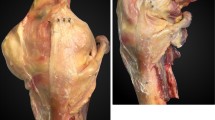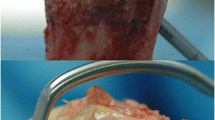Abstract
This study evaluated the healing process of an isolated medial collateral ligament (MCL) rupture at 12 weeks in a goat model. Using a robotic/UFS testing system, knee kinematics in multiple degrees of freedom and in situ forces in the healing MCL in response to (1) a 67-N anterior tibial load and (2) a 5-Nm valgus moment were evaluated as a function of angles of knee flexion. Then a uniaxial tensile test of femur-MCL-tibia complexes (FMTCs) was preformed to obtain the structural properties of the FMTC and mechanical properties of the healing MCL substance. The histological appearance of the healing MCL was also examined for collagen and cell organization. The anterior tibial translation in response to a 67-N anterior tibial load was found to range from 1.9 to 2.4 mm, which was not significantly different from the sham-operated, contralateral control knee. In response to a 5-Nm valgus moment, however, MCL injury caused a 40% or more increase in valgus rotations over sham-operated controls for all angles of knee flexion tested. The magnitudes of the in situ forces in the healing MCLs for neither external loading conditions differed from sham-operated controls. For the structural properties of the healing FMTC, the stiffness returned to sham-operated control levels, but ultimate load at failure remained 60% of sham-operated control values. In terms of mechanical properties of the healing MCL, its tangent modulus and stress at failure were only 40% of sham-operated control values. Histologically, the collagen and cell organization at the femoral and tibial insertions as well as the midsubstance remained disorganized. Comparing these data to those previously reported at 6 weeks, there was a marked improvement in the in situ forces in the healing MCL and of the stiffness of the FMTC. Also, the data obtained for the goat model revealed a faster healing process than those for the rabbit model. These findings suggest that greater post-injury activity levels may render the goat to be a better animal model for studying the healing process of the MCL.






Similar content being viewed by others
References
Amiel D, Kleiner JB, Akeson WH (1986) The natural history of the anterior cruciate ligament autograft of patellar tendon origin. Am J Sports Med 14:449–462
Anderson DR, Weiss JA, Takai S, Ohland KJ, Woo SL-Y (1992) Healing of the medial collateral ligament following a triad injury: a biomechanical and histological study of the knee in rabbits. J Orthop Res 10:485–495
Ballmer PM, Jakob RP (1988) The nonoperative treatment of isolated complete tears of the medial collateral ligament of the knee. A prospective study. Arch Orthop Trauma Surg 107:273–276
Boykiw R, Sciore P, Reno C, Marchuk L, Frank CB, Hart DA (1998) Altered levels of extracellular matrix molecule mRNA in healing rabbit ligaments. Matrix Biol 17:371–378
Bray RC, Shrive NG, Frank CB, Chimich DD (1992) The early effects of joint immobilization on medial collateral ligament healing in an ACL-deficient knee: a gross anatomic and biomechanical investigation in the adult rabbit model. J Orthop Res 10:157–166
Cooper RR, Misol S (1970) Tendon and ligament insertion: a light and electron microscopic study. J Bone Joint Surg Am 52:1–20
Ellsasser JC, Reynolds FC, Omohundro JR (1974) The non-operative treatment of collateral ligament injuries of the knee in professional football players. J Bone Joint Surg Am 56:1185–1190
Engle CP, Noguchi M, Ohland KJ, Shelley FJ, Woo SL-Y (1994) Healing of the rabbit medial collateral ligament following an O'Donoghue triad injury: effects of anterior cruciate ligament reconstruction. J Orthop Res 12:357–364
Fetto JF, Marshall JL (1978) Medial collateral ligament injuries of the knee: a rationale for treatment. Clin Orthop 132:206–218
Frank C, Woo SL-Y, Amiel D, Harwood F, Gomez M, Akeson W (1983) Medial collateral ligament healing: a multidisciplinary assessment in rabbits. Am J Sports Med 11:379–389
Frank C, McDonald D, Shrive N (1997) Collagen fibril diameters in the rabbit medial collateral ligament scar: a longer term assessment. Connect Tissue Res 36:261–269
Fujie H, Mabuchi K, Woo SL-Y, Livesay GA, Arai S, Tsukamoto Y (1993) The use of robotics technology to study human joint kinematics: a new methodology. J Biomech Eng 115:211–217
Fujie H, Livesay GA, Fujita M, Woo SL-Y (1996) Forces and moments in six-DOF at the human knee joint: mathematical description for control. J Biomech 29:1577–1585
Gomez MA, Woo SL-Y, Amiel D, Harwood F, Kitabayashi L, Matyas JR (1991) The effects of increased tension on healing medial collateral ligaments. Am J Sports Med 19:347–354
Hart DP, Dahners LE (1987) Healing of the medial collateral ligament in rats. The effects of repair, motion, and secondary stabilizing ligaments. J Bone Joint Surg Am 69:1194–1199
Indelicato PA (1995) Isolated medial collateral ligament injuries in the knee. J Am Acad Orthop Surg 3:9–14
Inoue M, Woo SL-Y, Gomez MA, Amiel D, Ohland KJ, Kitabayashi LR (1990) Effects of surgical treatment and immobilization on the healing of the medial collateral ligament: a long-term multidisciplinary study. Connect Tissue Res 25:13–26
Jackson DW, Grood ES, Goldstein JD, Rosen MA, Kurzweil PR, et al (1993) A comparison of patellar tendon autograft and allograft used for anterior cruciate ligament reconstruction in the goat model. Am J Sports Med 21:176–185
Kleiner JB, Amiel D, Harwood FL, Akeson WH (1989) Early histologic, metabolic, and vascular assessment of anterior cruciate ligament autografts. J Orthop Res 7:235–242
Lee TQ, Woo SL-Y (1988) A new method for determining cross-sectional shape and area of soft tissues. J Biomech Eng 110:110–114
Livesay GA, Fujie H, Kashiwaguchi S, Morrow DA, Fu FH, Woo SL-Y (1995) Determination of the in-situ forces and force distribution within the human anterior cruciate ligament. Ann Biomed Eng 23:467–474
Loitz-Ramage BJ, Frank CB, Shrive NG (1997) Injury size affects long-term strength of the rabbit medial collateral ligament. Clin Orthop 337:272–280
Ma CB, Papageogiou CD, Debski RE, Woo SL-Y (2000) Interaction between the ACL graft and MCL in a combined ACL+MCL knee injury using a goat model. Acta Orthop Scand 71:387–393
Miyasaka KC, Daniel DM, Stone ML, Hirshman P (1991) The incidence of knee ligament injuries in the general population. Am J Knee Surg 4:3–8
Ng GY, Oakes BW, Deacon OW, McLean ID, Lampard D (1995) Biomechanics of patellar tendon autograft for reconstruction of the anterior cruciate ligament in the goat: three year study. J Orthop Res 13:602–608
Niyibizi C, Sagarriga Visconti C, Gibson G, Kavalkovich K (1996) Identification and immunolocalization of type X collagen at the ligament-bone interface. Biochem Biophys Res Commun 222:584–589
Niyibizi C, Kavalkovich K, Yamaji T, Woo SL-Y (2000) Type V collagen is increased during rabbit medial collateral ligament healing. Knee Surg Sports Traumatol Arthrosc 8:281–285
Ohland KJM, Woo SL-Y, Weiss JM, Takai SM, Shelley FJM (1991) Healing of combined injuries of the rabbit medial collateral ligament and its insertions: a long term study on the effects of conservative vs. surgical treatment. ASME 20:447–448
Ohno K, Pomaybo AS, Schmidt CC, Levine RE, Ohland KJ, Woo SL-Y (1995) Healing of the medial collateral ligament after a combined medial collateral and anterior cruciate ligament injury and reconstruction of the anterior cruciate ligament: comparison of repair and nonrepair of medial collateral ligament tears in rabbits. J Orthop Res 13:442–449
Papageorgiou CD, Ma CB, Abramowitch SD, Clineff TD, Woo SL-Y (2001) A multidisciplinary study of the healing of an intraarticular anterior cruciate ligament graft in a goat model. Am J Sports Med 29:620–626
Reider B, Sathy MR, Talkington J, Blyznak N, Kollias S (1994) Treatment of isolated medial collateral ligament injuries in athletes with early functional rehabilitation. A five-year follow-up study. Am J Sports Med 22:470–477
Rudy T, Livesay GA, Xerogeanes JW, Takeda Y, Fu FH, Woo SL-Y (1994) A combined robotics/UFS approach to measure knee kinematics and determine in-situ ACL forces. Adv Bioeng 28:287–288
Sandberg R, Balkfors B, Nilsson B, Westlin N (1987) Operative versus non-operative treatment of recent injuries to the ligaments of the knee. A prospective randomized study. J Bone Joint Surg Am 69:1120–1126
Scheffler SU, Clineff TD, Papageorgiou CD, Debski RE, Benjamin C, Woo SL-Y (2001) Structure and function of the healing medial collateral ligament in a goat model. Ann Biomed Eng 29:173–180
Shelbourne KD, Patel DV (1995) Management of combined injuries of the anterior cruciate and medial collateral ligaments. J Bone Joint Surg Am 77:800–806
Shrive N, Chimich D, Marchuk L, Wilson J, Brant R, Frank C (1995) Soft-tissue "flaws" are associated with the material properties of the healing rabbit medial collateral ligament. J Orthop Res 13:923–929
Smutz WP, Drexler M, Berglund LJ, Growney E, An KN (1994) Accuracy of a video strain measurement system. Presented at ASB
Thornton GM, Leask GP, Shrive NG, Frank CB (2000) Early medial collateral ligament scars have inferior creep behaviour. J Orthop Res 18:238–246
Weiss JA, Woo SL-Y, Ohland KJ, Horibe S, Newton PO (1991) Evaluation of a new injury model to study medial collateral ligament healing: primary repair vs. nonoperative treatment. J Orthop Res 9:516–528
Woo SL-Y, Gomez MA, Seguchi Y, Endo CM, Akeson WH (1983) Measurement of mechanical properties of ligament substance from a bone-ligament-bone preparation. J Orthop Res 1:22–29
Woo SL-Y, Orlando CA, Camp JF, Akeson WH (1986) Effects of postmortem storage by freezing on ligament tensile behavior. J Biomech 19:399–404
Woo SL-Y, Inoue M, McGurk-Burleson E, Gomez MA (1987) Treatment of the medial collateral ligament injury. II. Structure and function of canine knees in response to differing treatment regimens. Am J Sports Med 15:22–29
Woo SL-Y, Danto MI, Ohland KJ, Lee TQ, Newton PO (1990) The use of a laser micrometer system to determine the cross-sectional shape and area of ligaments: a comparative study with two existing methods. J Biomech Eng 112:426–431
Woo SL-Y, Niyibizi C, Matyas J, Kavalkovich K, Weaver-Green C, Fox RJ (1997) Medial collateral knee ligament healing: combined medial collateral and anterior cruciate ligament injuries studied in rabbits. Acta Orthop Scand 68:142–148
Yamaji T, Levine RE, Woo SL-Y, Niyibizi C, Kavalkovich KW, Weaver-Green CM (1996) Medial collateral ligament healing one year after a concurrent medial collateral ligament and anterior cruciate ligament injury: an interdisciplinary study in rabbits. J Orthop Res 14:223–227
Acknowledgements
The authors acknowledge the technical support of Theodore Rudy, M.A., John D. Withrow, M.S., and Nobuyoshi Watanabe, M.D. as well as the financial support provided by the National Institute of Health Grant AR41820.
Author information
Authors and Affiliations
Corresponding author
Rights and permissions
About this article
Cite this article
Abramowitch, S.D., Papageorgiou, C.D., Debski, R.E. et al. A biomechanical and histological evaluation of the structure and function of the healing medial collateral ligament in a goat model. Knee Surg Sports Traumatol Arthrosc 11, 155–162 (2003). https://doi.org/10.1007/s00167-002-0336-5
Received:
Accepted:
Published:
Issue Date:
DOI: https://doi.org/10.1007/s00167-002-0336-5




